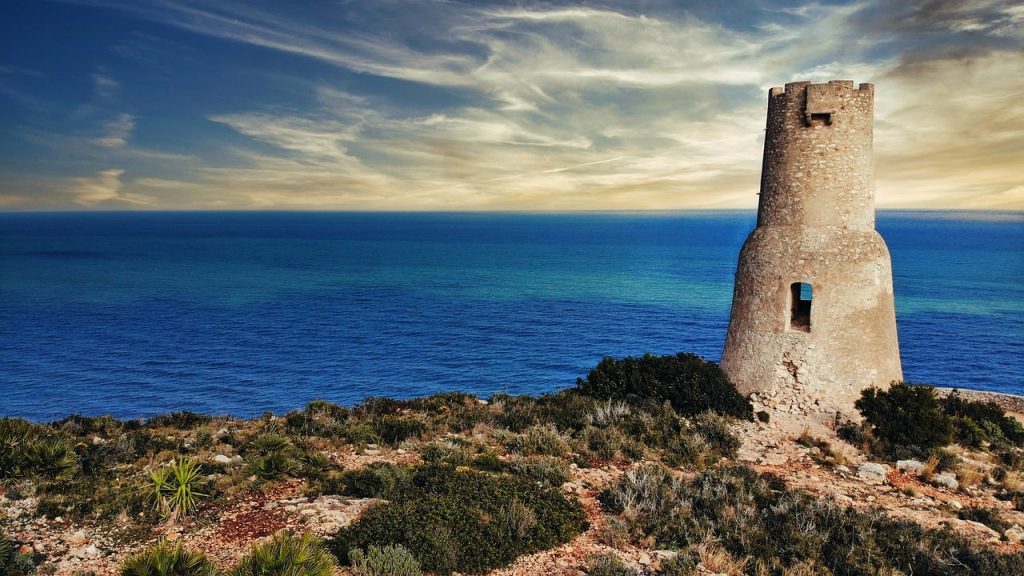Denia, a captivating coastal city in the province of Alicante, Spain, is not just a modern tourist destination but a place with a rich tapestry of history dating back to ancient times. Nestled on the Costa Blanca, the history of Denia is a fascinating story of conquests, cultural exchanges, and significant developments that have shaped its identity over the millennia.
Ancient Origins
The earliest settlements in the Denia area can be traced back to the prehistoric period, with evidence of human activity dating back to the Paleolithic era. However, it was during the Iberian period, around the 4th century BC, that Denia began to emerge as a significant settlement. The Iberians, the indigenous people of the area, established a thriving community, engaging in agriculture, fishing, and trade.
Greek and Roman Influence
The strategic location of Denia, overlooking the Mediterranean Sea, attracted the attention of the Greeks, who established a trading post here in the 6th century BC. They named it Hemeroskopeion, and it became a crucial point for commerce between Greece and the Iberian Peninsula. The Greeks introduced new agricultural practices, crafts, and trade goods, leaving a lasting impact on the region.
Following the Greeks, the Romans took control of the area in the 2nd century BC, incorporating it into the province of Hispania. They renamed the city Dianium, in honor of the goddess Diana, and it flourished under Roman rule. Denia became an important commercial and maritime center, with its port facilitating trade across the Mediterranean. The Romans also introduced architectural advancements, building roads, aqueducts, and public buildings, remnants of which can still be seen today.
Islamic Rule and the Reconquista
The 8th century marked the beginning of a new era for Denia, with the arrival of the Moors from North Africa. They fortified the city and expanded its port, making Denia a significant base for trade and military operations in the Mediterranean. The Moors introduced new agricultural techniques, such as the cultivation of rice and oranges, which are still prominent in the region's economy.
Denia reached its peak under Moorish rule in the 11th century when it became the capital of the Taifa of Denia, an independent Muslim kingdom. The city was known for its scholarly activities, luxury goods, and as a hub of cultural exchange between the Islamic world and Europe.
However, the Reconquista, the Christian reconquest of the Iberian Peninsula, led to significant changes. In 1244, Denia was captured by the forces of King James I of Aragon, and it became part of the Christian kingdom of Valencia. The transition from Islamic to Christian rule was marked by the construction of new religious and military buildings, including the impressive castle that dominates the city's skyline.
The Golden Age and Piracy
The 15th to 17th centuries represented a golden age for Denia, with the city prospering from trade and manufacturing. Denia became famous for its raisins, which were exported across Europe and the Americas. However, this period was also marked by conflict and piracy. The strategic position of Denia made it a target for Barbary pirates, leading to the fortification of the city and the construction of watchtowers along the coast.
Modern Times
The 19th and 20th centuries brought industrialization and the modernization of agricultural practices. The arrival of the railway in the late 19th century connected Denia with the rest of Spain, boosting the local economy. The 20th century saw the decline of traditional industries, but Denia adapted by developing its tourism sector. The city's beautiful beaches, historic sites, and gastronomy have made it a popular destination for visitors from around the world.
Today, Denia is recognized for its cultural heritage, being designated as a UNESCO Creative City of Gastronomy. The city continues to celebrate its rich history through festivals, such as the Fallas and the Moros y Cristianos, which commemorate its diverse cultural past.
Conclusion
The history of Denia is a testament to the city's resilience and adaptability. From its ancient origins to its modern-day status as a cultural and tourist hub, Denia has continuously evolved while preserving its rich heritage. This blend of ancient and modern, tradition and innovation, makes Denia a unique and fascinating place to explore. Whether it's wandering through its historic streets, enjoying its culinary delights, or relaxing on its sunny beaches, Denia offers a glimpse into the past and a vision of a vibrant future
Frequently Asked Questions (FAQs)
What is the historical significance of Denia, Spain?
Denia is a city with a rich history dating back to ancient times, featuring influences from the Iberians, Greeks, Romans, Moors, and Christians. Its strategic location has made it a significant maritime and trade center through the ages
How did the Greeks and Romans contribute to Denia's development?
The Greeks established a trading post, introducing new agricultural practices, while the Romans, renaming the city Dianium, enhanced its infrastructure and commerce, leaving behind architectural remnants
What impact did Islamic rule have on Denia?
Under Islamic rule, Denia became a prosperous trade and military base, known for its cultural exchange and the introduction of new agricultural techniques. It was also the capital of the Taifa of Denia
How did Denia change during the Reconquista?
Captured by King James I of Aragon in 1244, Denia transitioned to Christian rule, undergoing significant cultural and architectural changes, including the construction of its notable castle
What makes Denia a unique tourist destination today?
Denia's beautiful beaches, historic sites, rich cultural heritage, and designation as a UNESCO Creative City of Gastronomy make it a compelling destination for tourists seeking a blend of history, culture, and gastronomy

Pingback: Is Denia Worth Visiting? | Car Hire Denia